Tncc b - Study guides, Class notes & Summaries
Looking for the best study guides, study notes and summaries about Tncc b? On this page you'll find 1278 study documents about Tncc b.
Page 4 out of 1.278 results
Sort by
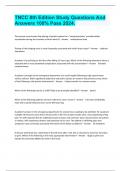
-
TNCC Bundled Package Deal 2024!
- Package deal • 17 items • 2024
-
- $25.49
- + learn more
1 Exam (elaborations) TNCC 8th Edition Study Questions And Answers 100% Pass 2024. 2 Exam (elaborations) TNCC Exam 8th Edition Study Questions And Answers Graded A+ 2024. 3 Exam (elaborations) TNCC Exam 8th edition Study Questions And Answers 100% Correct 2024. 4 Exam (elaborations) TNCC EXAM And QUALITY ANSWERS GRADED A+ PASSED 2024.
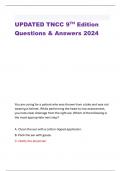
-
UPDATED TNCC 9TH Edition Questions & Answers 2024
- Exam (elaborations) • 17 pages • 2024
-
Available in package deal
-
- $15.99
- + learn more
UPDATED TNCC 9TH Edition Questions & Answers 2024 You are caring for a patient who was thrown from a bike and was not wearing a helmet. While performing the head-to-toe assessment, you note clear drainage from the right ear. Which of the following is the most appropriate next step? A. Clean the ear with a cotton-tipped applicator. B. Pack the ear with gauze. C. Notify the physician
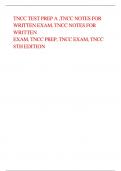
-
TNCC TEST PREP A ,TNCC NOTES FOR WRITTEN EXAM, TNCC NOTES FOR WRITTEN EXAM, TNCC PREP, TNCC EXAM, TNCC 8TH EDITIO
- Exam (elaborations) • 62 pages • 2024
-
- $20.49
- + learn more
TNCC TEST PREP A ,TNCC NOTES FOR WRITTEN EXAM, TNCC NOTES FOR WRITTEN EXAM, TNCC PREP, TNCC EXAM, TNCC 8TH EDITION What is the Mnemonic for the Initial Assessment? - A = Airway with simultaneous cervical spine protection B = Breathing C = Circulation D = Disability (neurologic status) E = Expose/Environmental controls (remove clothing and keep the patient warm) What is the Mnemonic for the Secondary Assessment? - F = Full set of VS/Focused adjuncts (includes cardiac monitor, urina...
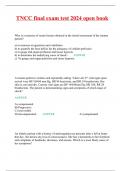
-
TNCC final exam test 2024 open book
- Exam (elaborations) • 18 pages • 2024
- Available in package deal
-
- $11.49
- + learn more
TNCC final exam test 2024 open book Why is a measure of serum lactate obtained in the initial assessment of the trauma patient? a) to measure oxygenation and ventilation b) to quantify the base deficit for the adequacy of cellular perfusion c) to gauge end-organ perfusion and tissue hypoxia d) to determine the underlying cause of shock - ANSWER c) *to gauge end-organ perfusion and tissue hypoxia
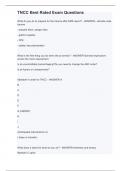
-
TNCC Best Rated Exam Questions
- Exam (elaborations) • 4 pages • 2024
- Available in package deal
-
- $9.49
- + learn more
What do you do to prepare for the trauma after EMS report? - ANSWER-- activate code trauma - prepare team, assign roles - gather supplies - PPE - safety/ decontamination What is the first thing you do when the pt arrives? - ANSWER-General impression/ across the room assessment Is pt uncontrollably hemorrhaging?Do you need to change the ABC order? Is pt Apneic or unresponsive? Alphabet in order for TNCC - ANSWER-A B C D E F G (LMNOP) H I J (Anticipated interventions 3) ...
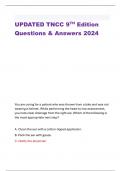
-
UPDATED TNCC 9TH Edition Questions & Answers 2024 You are caring for a patient who was thrown from a bike and was not wearing a helmet. While performing the head-to-toe assessment, you note clear drainage from the right ear. Which of the following is the
- Exam (elaborations) • 17 pages • 2024
-
Available in package deal
-
- $15.99
- + learn more
UPDATED TNCC 9TH Edition Questions & Answers 2024 You are caring for a patient who was thrown from a bike and was not wearing a helmet. While performing the head-to-toe assessment, you note clear drainage from the right ear. Which of the following is the most appropriate next step? A. Clean the ear with a cotton-tipped applicator. B. Pack the ear with gauze. C. Notify the physician You are caring for a patient who was thrown from a bike and was not wearing a helmet. While performing the hea...
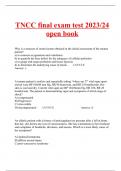
-
TNCC-Trauma Nursing Core Course
- Exam (elaborations) • 15 pages • 2024
-
- $11.49
- + learn more
TNCC final exam test 2023/24 open book Why is a measure of serum lactate obtained in the initial assessment of the trauma patient? a) to measure oxygenation and ventilation b) to quantify the base deficit for the adequacy of cellular perfusion c) to gauge end-organ perfusion and tissue hypoxia d) to determine the underlying cause of shock - ANSWER Answer: c
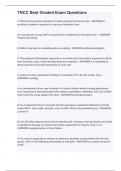
-
TNCC Best Graded Exam Questions
- Exam (elaborations) • 6 pages • 2024
- Available in package deal
-
- $9.99
- + learn more
C What are the primary benefits of a team approach to trauma care - ANSWER-it provides a systemic approach to care and organizes care A In the primary survey AVPU is performed to determine if the patient can: - ANSWER-Protect their aiway B WHich may lead to unreliable pulse ox reading - ANSWER-carboxyhemoglobin A The systemic inflammatory response is a normal part of the body's response to shock from traumatic injury. what best describes this response - ANSWER-it is activated by tissue...
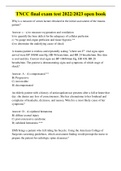
-
TNCC final exam test 2024 open book updated
- Exam (elaborations) • 14 pages • 2023
-
Available in package deal
-
- $11.74
- 1x sold
- + learn more
TNCC final exam test 2024 open book updated-Why is a measure of serum lactate obtained in the initial assessment of the trauma patient? Answer: c - a) to measure oxygenation and ventilation b) to quantify the base deficit for the adequacy of cellular perfusion c) *to gauge end-organ perfusion and tissue hypoxia ** d) to determine the underlying cause of shock A trauma patient is restless and repeatedly asking "where am I?" vital signs upon arrival were BP 100/60 mm Hg, HR 96 beats/min,...
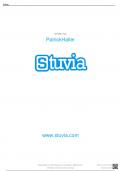
-
TNCC 9th Edition – Questions and Answers Graded A+ (SOLVED )
- Exam (elaborations) • 14 pages • 2023
-
- $29.99
- 1x sold
- + learn more
TNCC 9th Edition – Questions and Answers Graded A+ (SOLVED ) 1. An adult patient who sustained a severe head trauma has been intubated and is being manually ventilated via a bag-mask device at a rate of 18 breaths/minute. The patient has receive one intravenous fluid bolus 500 mL of warmed isotonic crystalloid solution. The PaCO2 is 30 mm Hg (4.0 kPa), and the pulse oximetry is 92%. BP is 142/70 mm Hg. What is the most important intervention to manage the cerebral blood flow? A. Decrease the ...

That summary you just bought made someone very happy. Also get paid weekly? Sell your study resources on Stuvia! Discover all about earning on Stuvia


